One of the beautiful teachings of our Catholic Faith is that concerning the Communion of Saints. The heroes of our Faith are not mere myths who have gone beyond us, like Greek heroes dancing in the night sky, nor are they historical curiosities, figures one might read about in some dusty tome of historiography. No, the saints are our family, and through the bounty of God’s eternal Love, we can speak to them and unite our prayer with theirs, so that together we can speak to the Father in praise and petition.
At the same time, there is a mystery to sanctity, for we do not know who around us will be added to the canon of the saints. Perhaps our friend or neighbor, or our sibling or coworker, might one day be recognized for their heroic virtues.
This mystery is nothing new. Even future saints spoke unawarely with other future saints about mundane matters. It is quite common to find the words of one saint-to-be written to another. From Paul’s letters to Timothy and Titus to messages from Pope John Paul II to Mother Teresa (and her back to him), we have in Church history a plethora of saintly correspondences.
Future saints likewise write about past saints, sometimes before the previous saint’s canonization. Classic examples include St. Athanasius writing about St. Anthony of Desert and St. Bonaventure composing a life of St. Francis of Assisi. Of course, many theologian saints consciously refer to the Church’s Tradition, purposely referencing saints of previous centuries.
Rarer than these, however, is a work written by a future saint, composed for (and dedicated to) another future saint, describing the deeds of previous historical saints. Yet this is exactly what we find in the Venerable Bede’s Ecclesiastical History of England. Bede, later canonized and recognized as a Doctor of the Church, wrote the History for English king (and saint) Ceolwulf. The work, as a history of the Church in England, discusses many saints, none more so than St. Augustine of Canterbury, who did more than anyone to establish the Church in England.
We thus have a saintly author writing of a saintly subject for a saintly audience.
Who were these three men? What can we draw from their stories? Let’s first take a look at St. Bede the Venerable.
Bede: The Historian
It is fittingly monkish that the majority of what we know about the Venerable Bede comes from a short author’s note he appended to his Ecclesiastical History. The note gives us the basic sketch of his life, and it is quickly apparent that Bede’s life was the monastic life. Bede was a man of the monastery. Bede notes how he was born, raised, and educated within the property of the Benedictine monastery at Wearmouth, in present-day Durham, UK. In Bede’s time, Wearmouth and the neighboring monastery of Jarrow formed a sort of super-monastery, separated only by the flow of the River Wear. The monastery’s founding dates to almost the exact year of Bede’s birth, meaning he and the monastery grew together. Aside from the occasional brief visits to friends or trips to preach at the request of kings, Bede spent his entire life within the monastery, studying, writing, teaching, and praying. That same autobiographical note of Bede’s spends about three times as much space discussing the scholarship of the author as it does the author’s life.
We can see in Bede the model of a scholar, not just a historian, but of any devoted to academic crafts. Bede is cautious about his sources, more comfortable in transcribing and quoting large passages, what we today might call primary sources, than in providing his own personal commentary. Bede preferred to let the past, his sources, speak through his history, include full texts of the letters he studied, rather than summarizing their content.
This genius in academic work did not go unnoticed. English kings came to Bede for advice (as we’ll see, this is precisely how Bede and King Ceolwulf began their spiritual relationship). Bede’s influence as a teacher spread beyond the coasts of England: one of the most influential English monks of the early middle ages, Alucin, the teacher of Charlemagne, was taught by one of Bede’s students.
History Written in Stone
While Bede’s life was more like that of a mundane monk, his monastery fared quite differently, thanks partly to its connection to Bede. Appropriately enough, considering one of her most famous monks is widely considered the father of English history, one could trace the history of the Catholic Church in England through the history of the Wearmouth-Jarrow monastery. Celtic Christianity flourished at Wearmouth-Jarrow, which became a center of learning for a Europe which had not yet fully embraced the Faith.
Just as the monastery reached its peak, the Vikings sailed to raid England, first at the famous monastery at Lindisfarne in 793, then Wearmouth-Jarrow in 794. This was a time for all of Christian Europe, but especially for religious monasteries, which were easy targets for raiding Vikings. The Norsemen laid waste to the monasteries, and it looked as if the legacy of Bede died with the flames.
Then came the Norman invasion of England (1066 and all that). There were attempts to rebuild Wearmouth-Jarrow, famous as the place where Bede had lived. However, such plans were cut short in the 1080s when Malcolm III of Scotland (the Malcolm who inherits the throne in Shakespeare’s Macbeth) destroyed the rebuilt monasteries. Again, all seemed lost for the patrimony of St. Bede.
Eventually, the monasteries were restored, though not for several centuries, and then at a miniscule portion of its former greatness (they became a subsection of the larger monastery in Durham, with only a few monks allowed to live there). Then came the dissolution of the monasteries under Henry VIII, which led to the land and the buildings passing hands several times; eventually, most of the buildings burned down, and secular owners moved onto the land. What was once a prosperous center of Christianity became just another tract of a noble’s land.
Yet it is this secularization which has preserved, to an extent, the legacy of Wearmouth-Jarrow and St. Bede. Today, the monastery’s grounds are part of a university, a museum, and an active archaeological dig, providing a light into what life was like during those so-called Dark Ages. The grounds were even nominated for inclusion in the list of UNESCO World Heritage sites. The proposal, which is still listed as “tentative” on the UNESCO website, refers to several aspects of the site’s historical and cultural value. In all of that, one name recurs throughout the proposal: Venerable Bede.
A Medieval Model
Although centuries separate us from those days of Christian flourishing in England, we can still see in Bede’s life a lesson in sanctity. We have already seen how students, writers, teachers, and scholars can all see in Bede a model of Christian scholarship. His works, the fruit of his labors, are Christ’s; so might be any of our works, whether manuscripts or manual labor, if we entrust them to Christ.
Bede was a man so close to Christ, so devoted to his religious life, that he was known as “Venerable Bede” even while he was alive. We see this, perhaps most clearly, with the words which close his famous history:
And I pray thee, loving Jesus, that as Thou hast graciously given me to drink in with delight the words of Thy knowledge, so Thou wouldst mercifully grant me to attain one day to Thee, the fountain of all wisdom and to appear forever before Thy face.
May this be our prayer always, no matter our vocation, no matter the age in which we live, and no matter where we find ourselves on our journey to sanctity.
✠
image: A detail from from a 14th century copy of Bede’s work, said to depict the saintly historian, found in BL Arundel 74, f. 2v / British Library (Public Domain)












